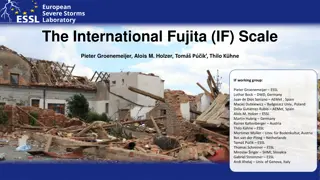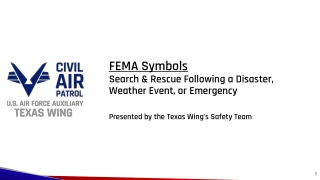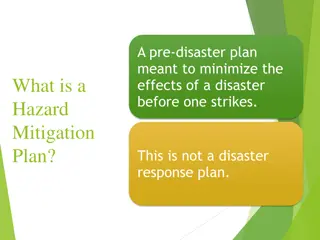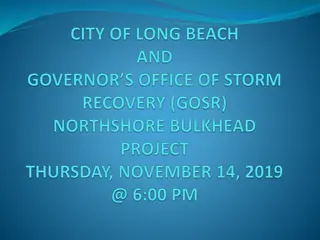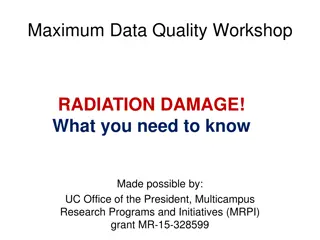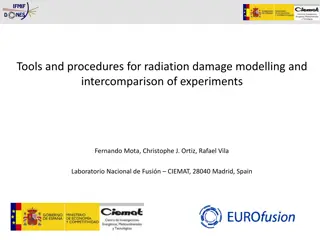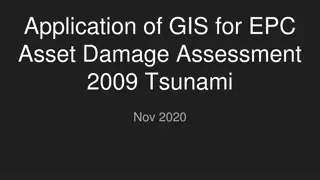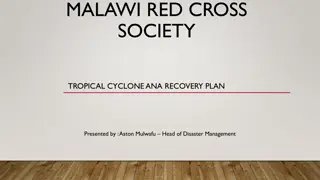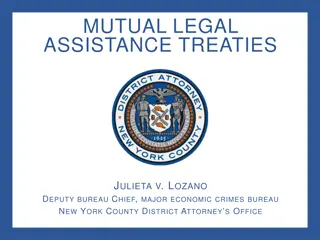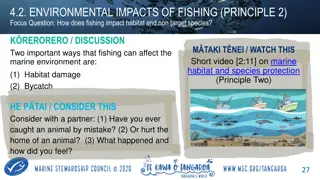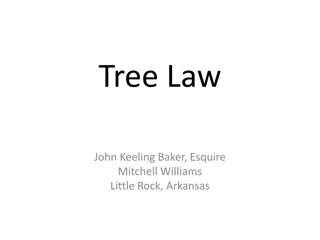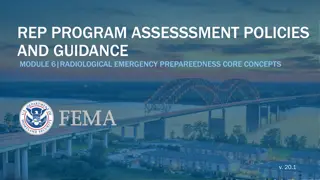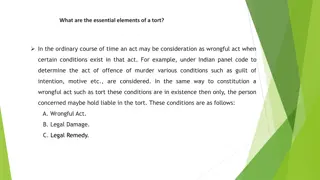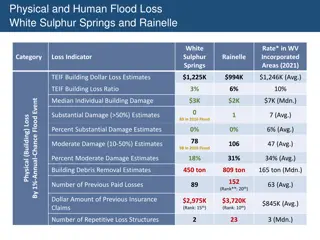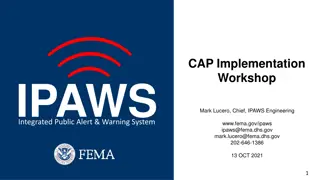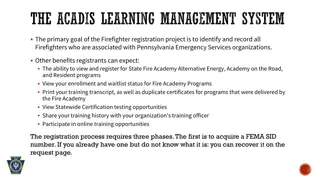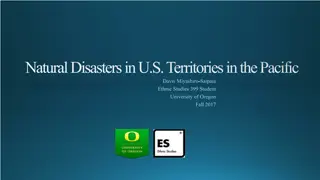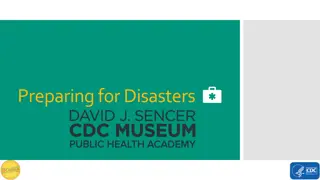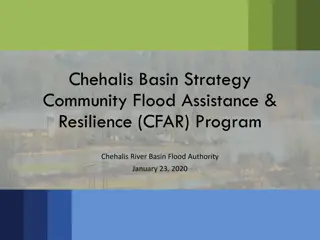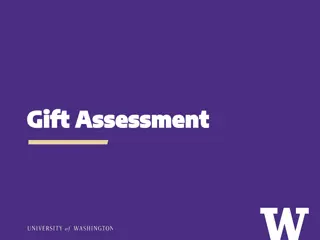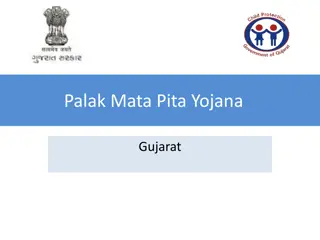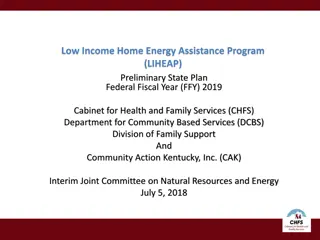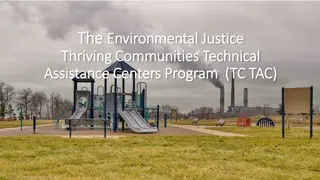Understanding FEMA Public Assistance Damage Assessment
This content provides a comprehensive overview of the damage assessment process in relation to the FEMA Public Assistance Grant Program. It covers eligibility, program details, per capita indicators, applicant eligibility, and facility eligibility. The visuals included help in understanding the key points of the process.
Download Presentation

Please find below an Image/Link to download the presentation.
The content on the website is provided AS IS for your information and personal use only. It may not be sold, licensed, or shared on other websites without obtaining consent from the author. Download presentation by click this link. If you encounter any issues during the download, it is possible that the publisher has removed the file from their server.
E N D
Presentation Transcript
MICHIGAN STATE POLICE PUBLIC ASSISTANCE DAMAGE ASSESSMENT 1
AGENDA Objective: Provide an overview of the damage assessment process as it relates to the FEMA Public Assistance (PA) Grant Program. PA Overview/Eligibility Damage Assessment Overview Additional Considerations Important Points to Remember Next Steps Questions 2
PUBLIC ASSISTANCE OVERVIEW & ELIGIBILITY 3
FEMA Public Assistance FEMA s Public Assistance Program provides supplemental grants to state, tribal, territorial, and local governments, and certain types of private non-profits so that communities can quickly respond to and recover from major disasters or emergencies. More detailed information can also be found in the FEMA Public Assistance Program and Policy Guide. 4
PUBLIC ASSISTANCE PROGRAM Assists in the restoration of community infrastructure to pre-disaster conditions Provides supplemental cost reimbursement with specific eligibility requirements FEMA provides funds to the State(Recipient) who reimburses eligible applicants for eligible activities 5
PER CAPITA INDICATORS/PROJECT THRESHOLDS FY 2023 Statewide Indicator for Presidential Declaration = $18.4 million
COUNTY INDICATORS - FEMA PUBLIC ASSISTANCE FY 2023 Statewide Indicator for Presidential Declaration = $18.4 million
APPLICANT ELIGIBILITY State, Tribal, Territorial, and Local Governments State Agencies Tribes Counties, Cities, Townships, and Villages Local public authorities School districts Special districts established under state law Certain Private Non-Profit (PNP) Organizations 8
FACILITY ELIGIBILITY Buildings, works, systems, or equipment, built or manufactured, or an improved and maintained natural feature Actively used at the time of the disaster Legally owned, operated, and regularly maintained
WORK ELIGIBILITY Be disaster-related Be located in the designated disaster area Be the legal responsibility Not fundable by another Federal agency
TYPES OF WORK Emergency Work A Debris Removal B Emergency Protective Measures Permanent Work C Road and Bridge Systems D Water Control Facilities E Public Buildings/Equipment F Public Utilities G Parks, Recreational, and Other Facilities
EMERGENCY WORK Category A Debris Removal Eliminates an immediate threat to life, health, and safety Eliminates an immediate threat of significant damage to improved property Ensures economic recovery of the community and provides a benefit for the community-at-large
CATEGORY A DEBRIS REMOVAL Removal of incident-related debris from public property and public rights-of-way (ROW) If residents are authorized to place incident-related debris on the ROW, costs to remove the debris may be reimbursable. Private property debris removal considerations (may not be eligible for PA) Generally, the responsibility of individual property owners. Must prove debris is a public health hazard and an immediate threat to life, public health, or safety, or economic recovery of the community at large. Requires written request and FEMA approval. **See FEMA Public Assistance: Debris Removal Tips and Private Property Debris Removal Fact Sheets
EMERGENCY WORK Category B Emergency Protective Measures Saves lives Protects public health and safety Protects improved property, or Eliminates or lessens an immediate threat of additional damage
PERMANENT WORK Categories C G Must repair, restore, or replace disaster- damaged facilities Must restore to pre-disaster design, capacity, and function, in accordance with applicable codes and standards Must be required as a result of the disaster Conforms to current codes and standards May include cost-effective hazard mitigation measures
CATEGORY B: FORCE ACCOUNT LABOR Permanent Work Labor Eligibility Budgeted Employees Unbudgeted Employees Overtime Straight-Time 18
COST ELIGIBILITY To be eligible for reimbursement, costs must be: Incurred from eligible work and adequately documented; Reduced by insurance proceeds, salvage value, or other credits; Authorized and permitted under Federal, State, Tribal, or local government laws or regulations; Consistent with the Applicant s internal policies, regulations, and procedures; and Necessary and reasonable to accomplish the work properly and efficiently. 19
DAMAGE ASSESSMENT OVERVIEW 20
DAMAGE ASSESSMENT PROCESS Three-Step Process Locals Identify damages during the Initial Damage Assessment State Verify and analyze damages State and Federal the State and FEMA conduct a Joint Preliminary Damage Assessment (PDA)
DAMAGE ASSESSMENT PROCESS Local Level: Initial Damage Assessment The local emergency manager is responsible for collecting data to determine the amount of damage caused by the disaster: Coordinating assessment activity in the jurisdiction Charging damage assessment teams with identifying and collecting data on damages Submitting data to MI CIMS normally within 72 hours of the incident
Local (Initial) Damage Assessment Essential Elements of Information/Documentation from Locals to determine if the incident is of such severity and magnitude that resources for recovery are expected to exceed state, Tribal or territorial government capability. Map damage locations Take photographs Estimate costs for work to be completed by location and category of work Obtain bills, invoices, and receipts for eligible work completed Deduct anticipated insurance proceeds Review procurement policies COMPLETE and ORGANIZED Documentation ENTER Damage and Impacts into MI CIMS
DAMAGE ASSESSMENT PROCESS State Level: Verification and Analysis The State Director of Emergency Management is responsible for overseeing damage assessments, verification of local data, and validation activities to verify local damage assessment findings.
DAMAGE ASSESSMENT PROCESS Joint PDA: Validate Damage Assessment Data If the severity and magnitude of the incident are expected to exceed the availability and capability of local and state resources to recover, the State Director of Emergency Management may request a Joint PDA from the FEMA Regional Administrator (RA) to validate damage and evaluate impact. The purpose of the Joint PDA is to validate not find damage and impacts of the damage that have already been identified.
PRELIMINARY DAMAGE ASSESSMENT (PDA) The PDA process is a mechanism used to determine the impact and magnitude of damage and the resulting unmet needs of individuals, businesses, the public sector, and the community. Information collected is used by the state as a basis for the governor's request and by FEMA to document the recommendation made to the President in response to the governor's request. With the support of the state, tribe, or territory, local governments first conduct initial damage assessments (IDA) to determine if they require federal support. Once SLTT governments determine their capability to respond to or recover from the event is exceeded, the state, tribe, or territory requests a joint PDA with FEMA. 26
Damage Assessment PA Factors To determine need for Federal assistance: 1. Estimated cost of assistance 2. Localized impacts 3. Insurance coverage in force 4. Hazard Mitigation 5. Recent multiple disasters 6. Assistance available from other agencies Documentation is REQUIRED to validate costs!!!
PRELIMINARY DAMAGE ASSESSMENT (PDA) Step 1 Identify Potential Applicants and Damaged Facilities Step 2 Document Damage, Work, and Cost By Category Labor (Force Account) Equipment (Force Account) Leased Equipment Materials/Supplies
PRELIMINARY DAMAGE ASSESSMENT PA TEAMS Required Documentation: Map of entire affected area, marking sites if possible Work completed documentation or all actual costs incurred Force account labor, equipment, and supply documentation from the internal systems that establish the basis for costs claimed Budget information For debris costs, actual documentation or estimate of reasonable costs Insurance policy Videos, still photos or diagrams, especially for Emergency Work
PUBLIC ASSISTANCE ADDITIONAL CONSIDERATIONS 30
Procurement under Exigency or Emergency Circumstances Emergency: an unexpected and unusually dangerous situation that calls for immediate action or an urgent need for assistance or relief. E.g. threat to life, public health or safety, improved property, and/or some other form of dangerous situation. Exigency: something that is necessary in a particular situation that requires or demands immediate aid or action. Procurement Disaster Assistance Team (PDAT) online provides tools and resources 31
Sole-Source Procurement E&E Situations that demand If using sole sourcing due to emergency or exigency, you must: immediate aid or action Emergency Exigency Justify with documentation Need to alleviate a threat to life, Need to avoid, prevent or alleviate Use only during the period of actual exigent or emergency circumstances public health or safety, or serious harm or injury, financial or improved property otherwise $ Transition to a competitive method as soon as period ends Insert Recipient Logo Presenter s Name June 17, 2003 32
Procurement Under E&E If sole-sourcing under the E&E exception, non-state entities MUST: Include required contract clauses (also applicable to states) 2 C.F.R. 200.326 & Appendix II Follow time and materials contract requirements, if applicable 2 C.F.R. 200.318(j) NOT enter into cost-plus-percentage-of-cost contracts (prohibited) 2 C.F.R. 200.323(c) Award contract to a responsible contractor 2 C.F.R. 200.318(h) Follow documentation, oversight, conflict of interest requirements 2 C.F.R. 200.318 Insert Recipient Logo Presenter s Name June 17, 2003 33
NEXT STEPS 34
DOCUMENTATION NEXT STEPS Prioritized list of damages (form required) Supporting documents for actual and estimated costs General documents - labor, insurance, procurement policies Locals Submit Supporting documents for each site Assists locals to address ineligible items IMPORTANT - Costs cannot be included without documentation State Validates Based on its validation of costs, determines if the a joint preliminary damage assessment (locals, state, and FEMA) is warranted. State Requests Joint PDA?
NEXT STEPS POTENTIAL PA APPLICANTS Submit the following information: List of damaged sites in order by priority and highest estimate ***Assigning each site a number for file naming is helpful Detailed description of damages for each Bills, invoices, and receipts for eligible work completed Photos for each damaged site or a representative sample of photos Labor policy in effect at the time of the incident Maintenance records for each facility Insurance policies (deduct anticipated insurance proceeds) Procurement policies and pertinent contracts and MOAs 36
DAMAGE SUMMARY LIST (REQUIRED FORM) Basic information Category - drop-down list of FEMA PA Categories Name of damage/facility Primary address 38
DAMAGE SUMMARY LIST (REQUIRED FORM) Enter address 2 (if applicable), city, state, zip, latitude and longitude Describe Damage by providing a detailed description to that facility or site; be sure to include dimensions, materials, and the size or capacity, if applicable 39
DAMAGE SUMMARY LIST (REQUIRED FORM) Primary Cause of Damage drop- down list Approx. Cost include only eligible costs (exclude FHWA roads, anticipated insurance proceeds, etc.) % Work Complete Labor Type choose from drop- down list (see list tab for acronym list) Has received PA grants in the past for this facility, yes or no option Priority Number the number YOU assign to each Applicant Priority drop-down list (low, medium, high, urgent) 40
NEXT STEPS MSP/EMHSD Reviews and validates submitted disaster information for completeness and potential eligibility issues Determines if a joint PDA with FEMA is warranted 41
FACT SHEETS & GUIDANCE Below is a list of FEMA Fact Sheets and Guidance: 1. Damage Inventory Form 2. Public Assistance Work Eligibility Matrix and Checklist 3. Initial Damage Assessment (IDA) Checklist 4. FEMA Fact Sheet: Procurement Under Grants Conducted Under Exigent or Emergency Circumstances 5. The federal procurement under grant rules are found at 2 C.F.R. 200.317-200.326 6. Public Assistance Program and Policy Guide (PAPPG) 42
IMPORTANT POINTS TO REMEMBER 1. Federal Highway Roads (FHWA) should NOT be included in road repair estimates 2. Anticipated insurance proceeds should be deducted from estimates 3. Provide photos as damage assessment should contain visual confirmation of damage information for the damage to be considered valid 4. List of sites with hardest impacted areas with most extensively damaged sites listed first (Damage Inventory Form) 5. Provide a detailed description of the damage to that facility or site; be sure to include damage dimensions, materials, and the size or capacity of damaged facility elements if applicable 6. No lump sum amounts (cannot determine how amounts was arrived at) 7. Remember to follow local and federal procurement rules 8. DOCUMENT, DOCUMENT, DOCUMENT!!! 43
LESSONS LEARNED Pre-existing damages will be deducted and ineligible (i.e., alligator cracking, lack of gravel and other maintenance Unable to demonstrate damages are directly related to the disaster Codes & Standards (EGLE) No lump sum amounts (cannot determine how amounts was arrived at) 44
Contact Information Ms. Tiffany Vedder, PEM State Public Assistance Officer Cell: 517-599-5333 veddert@michigan.gov Ms. Marisela Shellenbarger, PEM Deputy Public Assistance Officer Cell: 517-512-9676 shellenbargerm@michigan.gov Ms. Deressa Walker Public Assistance Analyst Cell: 517-614-6824 walkerd49@michigan.gov Ms. Ashley Goodwin Public Assistance Analyst Cell: 517-243-8617 goodwinA2@michigan.gov Public Assistance Mailbox: MSP-EMHSD-DisasterPA@Michigan.gov 45



